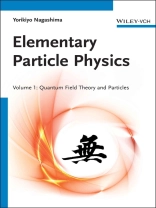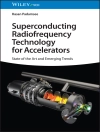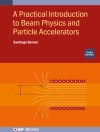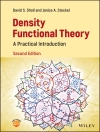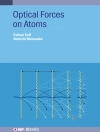ACCOUNTING PRINCIPLES
Meeting the need for a coherently written and comprehensive compendium combining field theory and particle physics for advanced students and researchers, this volume directly links the theory to the experiments. It is clearly divided into two sections covering approaches to field theory and the Standard Model, and rounded off with numerous useful appendices. A timely work for high energy and theoretical physicists, as well as astronomers, graduate students and lecturers in physics.
From the contents:
- Particles and Fields
- Lorentz Invariance
- Dirac Equation
- Field Quantization
- Scattering Matrix
- QED: Quantum Electrodynamics
- Radiative Corrections and Tests of Qed
- Symmetries
- Path Integral : Basics
- Path Integral Approach to Field Theory
- Accelerator and Detector Technology
- Spectroscopy
- The Quark Model
- Weak Interaction
- Neutral Kaons and CP Violation
- Hadron Structure
- Gauge Theories
- Appendices
Volume 2 (2013, ISBN 3-527-40966-1) will concentrate on the main aspects of the Standard Model by addressing its recent developments and future prospects. Furthermore, it will give some thought to intriguing ideas beyond the Standard Model, including the Higgs boson, the neutrino, the concepts of the Grand Unified Theory and supersymmetry, axions, and cosmological developments.
表中的内容
Foreword V
Preface XVII
Acknowledgements XXI
Part One a Field Theoretical Approach 1
1 Introduction 3
1.1 An Overview of the Standard Model 3
1.1.1 What is an Elementary Particle? 3
1.1.2 The Four Fundamental Forces and Their Unification 4
1.1.3 The Standard Model 7
1.2 The Accelerator as a Microscope 11
2 Particles and Fields 13
2.1 What is a Particle? 13
2.2 What is a Field? 21
2.2.1 Force Field 21
2.2.2 Relativistic Wave Equation 25
2.2.3 Matter Field 27
2.2.4 Intuitive Picture of a Field and Its Quantum 28
2.2.5 Mechanical Model of a Classical Field 29
2.3 Summary 32
2.4 Natural Units 33
3 Lorentz Invariance 37
3.1 Rotation Group 37
3.2 Lorentz Transformation 41
3.2.1 General Formalism 41
3.2.2 Lorentz Vectors and Scalars 43
3.3 Space Inversion and Time Reversal 45
3.4 Covariant Formalism 47
3.4.1 Tensors 47
3.4.2 Covariance 48
3.4.3 Supplementing the Time Component 49
3.4.4 Rapidity 51
3.5 Lorentz Operator 53
3.6 Poincaré Group* 56
4 Dirac Equation 59
4.1 Relativistic Schrödinger Equation 59
4.1.1 Dirac Matrix 59
4.1.2 Weyl Spinor 61
4.1.3 Interpretation of the Negative Energy 64
4.1.4 Lorentz-Covariant Dirac Equation 69
4.2 Plane-Wave Solution 71
4.3 Properties of the Dirac Particle 75
4.3.1 Magnetic Moment of the Electron 75
4.3.2 Parity 77
4.3.3 Bilinear Form of the Dirac Spinor 78
4.3.4 Charge Conjugation 79
4.3.5 Chiral Eigenstates 82
4.4 Majorana Particle 84
5 Field Quantization 89
5.1 Action Principle 89
5.1.1 Equations of Motion 89
5.1.2 Hamiltonian Formalism 90
5.1.3 Equation of a Field 91
5.1.4 Noether’s Theorem 95
5.2 Quantization Scheme 100
5.2.1 Heisenberg Equation of Motion 100
5.2.2 Quantization of the Harmonic Oscillator 102
5.3 Quantization of Fields 105
5.3.1 Complex Fields 106
5.3.2 Real Field 111
5.3.3 Dirac Field 112
5.3.4 Electromagnetic Field 114
5.4 Spin and Statistics 119
5.5 Vacuum Fluctuation 121
5.5.1 The Casimir Effect* 122
6 Scattering Matrix 127
6.1 Interaction Picture 127
6.2 Asymptotic Field Condition 131
6.3 Explicit Form of the S-Matrix 133
6.3.1 Rutherford Scattering 135
6.4 Relativistic Kinematics 136
6.4.1 Center of Mass Frame and Laboratory Frame 136
6.4.2 Crossing Symmetry 139
6.5 Relativistic Cross Section 141
6.5.1 Transition Rate 141
6.5.2 Relativistic Normalization 142
6.5.3 Incoming Flux and Final State Density 144
6.5.4 Lorentz-Invariant Phase Space 145
6.5.5 Cross Section in the Center of Mass Frame 145
6.6 Vertex Functions and the Feynman Propagator 147
6.6.1 eeγ Vertex Function 147
6.6.2 Feynman Propagator 151
6.7 Mott Scattering 157
6.7.1 Cross Section 157
6.7.2 Coulomb Scattering and Magnetic Scattering 161
6.7.3 Helicity Conservation 161
6.7.4 A Method to Rotate Spin 161
6.8 Yukawa Interaction 162
7 Qed: Quantum Electrodynamics 167
7.1 e–μ Scattering 167
7.1.1 Cross Section 167
7.1.2 Elastic Scattering of Polarized e–μ 171
7.1.3 e_ e+ + μ_ μ+ Reaction 174
7.2 Compton Scattering 176
7.3 Bremsstrahlung 181
7.3.1 Soft Bremsstrahlung 183
7.4 Feynman Rules 186
8 Radiative Corrections and Tests of Qed* 191
8.1 Radiative Corrections and Renormalization* 191
8.1.1 Vertex Correction 191
8.1.2 Ultraviolet Divergence 193
8.1.3 Infrared Divergence 197
8.1.4 Infrared Compensation to All Orders* 199
8.1.5 Running Coupling Constant 204
8.1.6 Mass Renormalization 208
8.1.7 Ward–Takahashi Identity 210
8.1.8 Renormalization of the Scattering Amplitude 211
8.2 Tests of QED 213
8.2.1 Lamb Shift 213
8.2.2g – 2 214
8.2.3 Limit of QED Applicability 216
8.2.4 E821 BNL Experiment 216
9 Symmetries 221
9.1 Continuous Symmetries 222
9.1.1 Space and Time Translation 223
9.1.2 Rotational Invariance in the Two-Body System 227
9.2 Discrete Symmetries 233
9.2.1 Parity Transformation 233
9.2.2 Time Reversal 240
9.3 Internal Symmetries 251
9.3.1 U(1) Gauge Symmetry 251
9.3.2 Charge Conjugation 252
9.3.3 CPT Theorem 258
9.3.4 SU(2) (Isospin) Symmetry 260
10 Path Integral: Basics 267
10.1 Introduction 267
10.1.1 Bra and Ket 267
10.1.2 Translational Operator 268
10.2 Quantum Mechanical Equations 271
10.2.1 Schrödinger Equation 271
10.2.2 Propagators 272
10.3 Feynman’s Path Integral 274
10.3.1 Sum over History 274
10.3.2 Equivalence with the Schrödinger Equation 278
10.3.3 Functional Calculus 279
10.4 Propagators: Simple Examples 282
10.4.1 Free-Particle Propagator 282
10.4.2 Harmonic Oscillator 285
10.5 Scattering Matrix 294
10.5.1 Perturbation Expansion 295
10.5.2 S-Matrix in the Path Integral 297
10.6 Generating Functional 300
10.6.1 Correlation Functions 300
10.6.2 Note on Imaginary Time 302
10.6.3 Correlation Functions as Functional Derivatives 304
10.7 Connection with Statistical Mechanics 306
11 Path Integral Approach to Field Theory 311
11.1 From Particles to Fields 311
11.2 Real Scalar Field 312
11.2.1 Generating Functional 312
11.2.2 Calculation of det A 315
11.2.3 n-Point Functions and the Feynman Propagator 318
11.2.4 Wick’s Theorem 319
11.2.5 Generating Functional of Interacting Fields 320
11.3 Electromagnetic Field 321
11.3.1 Gauge Fixing and the Photon Propagator 321
11.3.2 Generating Functional of the Electromagnetic Field 323
11.4 Dirac Field 324
11.4.1 Grassmann Variables 324
11.4.2 Dirac Propagator 331
11.4.3 Generating Functional of the Dirac Field 332
11.5 Reduction Formula 333
11.5.1 Scalar Fields 333
11.5.2 Electromagnetic Field 337
11.5.3 Dirac Field 337
11.6 QED 340
11.6.1 Formalism 340
11.6.2 Perturbative Expansion 342
11.6.3 First-Order Interaction 343
11.6.4 Mott Scattering 345
11.6.5 Second-Order Interaction 346
11.6.6 Scattering Matrix 351
11.6.7 Connected Diagrams 353
11.7 Faddeev–Popov’s Ansatz* 354
11.7.1 A Simple Example* 355
11.7.2 Gauge Fixing Revisited* 356
11.7.3 Faddeev–Popov Ghost* 359
12 Accelerator and Detector Technology 363
12.1 Accelerators 363
12.2 Basic Parameters of Accelerators 364
12.2.1 Particle Species 364
12.2.2 Energy 366
12.2.3 Luminosity 367
12.3 Various Types of Accelerators 369
12.3.1 Low-Energy Accelerators 369
12.3.2 Synchrotron 373
12.3.3 Linear Collider 377
12.4 Particle Interactions with Matter 378
12.4.1 Some Basic Concepts 378
12.4.2 Ionization Loss 381
12.4.3 Multiple Scattering 389
12.4.4 Cherenkov and Transition Radiation 390
12.4.5 Interactions of Electrons and Photons with Matter 394
12.4.6 Hadronic Shower 401
12.5 Particle Detectors 403
12.5.1 Overview of Radioisotope Detectors 403
12.5.2 Detectors that Use Light 404
12.5.3 Detectors that Use Electric Signals 410
12.5.4 Functional Usage of Detectors 415
12.6 Collider Detectors 422
12.7 Statistics and Errors 428
12.7.1 Basics of Statistics 428
12.7.2 Maximum Likelihood and Goodness of Fit 433
12.7.3 Least Squares Method 438
13 Spectroscopy 443
13.1 Pre-accelerator Age (1897–1947) 444
13.2 Pions 449
13.3 πN Interaction 454
13.3.1 Isospin Conservation 454
13.3.2 Partial Wave Analysis 462
13.3.3 Resonance Extraction 466
13.3.4 Argand Diagram: Digging Resonances 472
13.4 ƿ (770) 475
13.5 Final State Interaction 478
13.5.1 Dalitz Plot 478
13.5.2 K Meson 481
13.5.3 Angular Momentum Barrier 484
13.5.4 ω Meson 485
13.6 Low-Energy Nuclear Force 487
13.6.1 Spin–Isospin Exchange Force 487
13.6.2 Effective Range 490
13.7 High-Energy Scattering 491
13.7.1 Black Sphere Model 491
13.7.2 Regge Trajectory* 494
14 The Quark Model 501
14.1 SU(3) Symmetry 501
14.1.1 The Discovery of Strange Particles 502
14.1.2 The Sakata Model 505
14.1.3 Meson Nonets 507
14.1.4 The Quark Model 509
14.1.5 Baryon Multiplets 510
14.1.6 General Rules for Composing Multiplets 511
14.2 Predictions of SU(3) 513
14.2.1 Gell-Mann–Okubo Mass Formula 513
14.2.2 Prediction of Ω 514
14.2.3 Meson Mixing 516
14.3 Color Degrees of Freedom 519
14.4 SU(6) Symmetry 522
14.4.1 Spin and Flavor Combined 522
14.4.2 SU(6) _ O(3) 525
14.5 Charm Quark 525
14.5.1 J/ψ 525
14.5.2 Mass and Quantum Number of J/ψ 527
14.5.3 Charmonium 527
14.5.4 Width of J/ψ 533
14.5.5 Lifetime of Charmed Particles 536
14.5.6 Charm Spectroscopy: SU(4) 537
14.5.7 The Fifth Quark b (Bottom) 539
14.6 Color Charge 539
14.6.1 Color Independence 542
14.6.2 Color Exchange Force 544
14.6.3 Spin Exchange Force 545
14.6.4 Mass Formulae of Hadrons 547
15 Weak Interaction 553
15.1 Ingredients of the Weak Force 553
15.2 Fermi Theory 555
15.2.1 Beta Decay 555
15.2.2 Parity Violation 562
15.2.3 π Meson Decay 564
15.3 Chirality of the Leptons 567
15.3.1 Helicity and Angular Correlation 567
15.3.2 Electron Helicity 569
15.4 The Neutrino 571
15.4.1 Detection of the Neutrino 571
15.4.2 Mass of the Neutrino 572
15.4.3 Helicity of the Electron Neutrino 576
15.4.4 The Second Neutrino νμ 578
15.5 The Universal V–A Interaction 579
15.5.1 Muon Decay 579
15.5.2 CVC Hypothesis 584
15.6 Strange Particle Decays 589
15.6.1 ΔS = ΔQ Rule 589
15.6.2 ΔI = 1/2 Rule 591
15.6.3 Kl3 : K+ → π0 + l+ + ν 592
15.6.4 Cabibbo Rotation 596
15.7 Flavor Conservation 598
15.7.1 GIM Mechanism 598
15.7.2 Kobayashi–Maskawa Matrix 600
15.7.3 Tau Lepton 601
15.7.4 The Generation Puzzle 605
15.8 A Step Toward a Unified Theory 608
15.8.1 Organizing the Weak Phenomena 608
15.8.2 Limitations of the Fermi Theory 610
15.8.3 Introduction of SU(2) 614
16 Neutral Kaons and CP Violation* 617
16.1 Introduction 618
16.1.1 Strangeness Eigenstates and CP Eigenstates 618
16.1.2 Schrödinger Equation for K0 – K0 States 619
16.1.3 Strangeness Oscillation 622
16.1.4 Regeneration of K1 626
16.1.5 Discovery of CP Violation 630
16.2 Formalism of CP and CPT Violation 632
16.2.1 CP, T, CPT Transformation Properties 632
16.2.2 Definition of CP Parameters 635
16.3 CP Violation Parameters 640
16.3.1 Observed Parameters 640
16.3.2 є and є’ 644
16.4 Test of T and CPT Invariance 653
16.4.1 Definition of T- and CPT-Violating Amplitudes 654
16.4.2 T Violation 654
16.4.3 CPT violation 656
16.4.4 Possible Violation of Quantum Mechanics 662
16.5 Experiments on CP Parameters 664
16.5.1 CPLEAR 664
16.5.2 NA48/KTe V 666
16.6 Models of CP Violation 673
17 Hadron Structure 679
17.1 Historical Overview 679
17.2 Form Factor 680
17.3 e–p Elastic Scattering 683
17.4 Electron Proton Deep Inelastic Scattering 687
17.4.1 Cross-Section Formula for Inelastic Scattering 687
17.4.2 Bjorken Scaling 690
17.5 Parton Model 693
17.5.1 Impulse Approximation 693
17.5.2 Electron–Parton Scattering 696
17.6 Scattering with Equivalent Photons 699
17.6.1 Transverse and Longitudinal Photons 699
17.6.2 Spin of the Target 702
17.6.3 Photon Flux 703
17.7 How to Do Neutrino Experiments 705
17.7.1 Neutrino Beams 705
17.7.2 Neutrino Detectors 709
17.8 ν–p Deep Inelastic Scattering 712
17.8.1 Cross Sections and Structure Functions 712
17.8.2 ν, ν–q Scattering 715
17.8.3 Valence Quarks and Sea Quarks 716
17.8.4 Comparisons with Experimental Data 717
17.8.5 Sum Rules 719
17.9 Parton Model in Hadron–Hadron Collisions 721
17.9.1 Drell–Yan Process 721
17.9.2 Other Hadronic Processes 724
17.10 A Glimpse of QCD’s Power 725
18 Gauge Theories 729
18.1 Historical Prelude 729
18.2 Gauge Principle 731
18.2.1 Formal Definition 731
18.2.2 Gravity as a Geometry 733
18.2.3 Parallel Transport and Connection 734
18.2.4 Rotation in Internal Space 737
18.2.5 Curvature of a Space 739
18.2.6 Covariant Derivative 741
18.2.7 Principle of Equivalence 743
18.2.8 General Relativity and Gauge Theory 745
18.3 Aharonov–Bohm Effect 748
18.4 Nonabelian Gauge Theories 754
18.4.1 Isospin Operator 754
18.4.2 Gauge Potential 755
18.4.3 Isospin Force Field and Equation of Motion 757
18.5 QCD 760
18.5.1 Asymptotic Freedom 762
18.5.2 Confinement 767
18.6 Unified Theory of the Electroweak Interaction 770
18.6.1 SU(2) _ U(1) Gauge Theory 770
18.6.2 Spontaneous Symmetry Breaking 774
18.6.3 Higgs Mechanism 778
18.6.4 Glashow–Weinberg–Salam Electroweak Theory 782
18.6.5 Summary of GWS Theory 784
19 Epilogue 787
19.1 Completing the Picture 788
19.2 Beyond the Standard Model 789
19.2.1 Neutrino Oscillation 789
19.2.2 GUTs: Grand Unified Theories 791
19.2.3 Supersymmetry 792
19.2.4 Superstring Model 795
19.2.5 Extra Dimensions 796
19.2.6 Dark Matter 797
19.2.7 Dark Energy 798
Appendix A Spinor Representation 803
A.1 Definition of a Group 803
A.1.1 Lie Group 804
A.2 SU(2) 805
A.3 Lorentz Operator for Spin 1/2 Particle 809
A.3.1 SL(2, C) Group 809
A.3.2 Dirac Equation: Another Derivation 811
Appendix B Coulomb Gauge 813
B.1 Quantization of the Electromagnetic Field in the Coulomb Gauge 814
Appendix C Dirac Matrix and Gamma Matrix Traces 817
C.1 Dirac Plane Wave Solutions 817
C.2 Dirac γ Matrices 817
C.2.1 Traces of the γ Matrices 818
C.2.2 Levi-Civita Antisymmetric Tensor 819
C.3 Spin Sum of |Mfi|2 819
C.3.1 A Frequently Used Example 820
C.3.2 Polarization Sum of the Vector Particle 822
C.4 Other Useful Formulae 823
Appendix D Dimensional Regularization 825
D.1 Photon Self-Energy 825
D.2 Electron Self-Energy 830
Appendix E Rotation Matrix 833
E.1 Angular Momentum Operators 833
E.2 Addition of the Angular Momentum 835
E.3 Rotational Matrix 835
Appendix F C, P, T Transformation 839
Appendix G SU(3), SU(n) and the Quark Model 841
G.1 Generators of the Group 841
G.1.1 Adjoint Representation 842
G.1.2 Direct Product 843
G.2 SU(3) 844
G.2.1 Structure Constants 844
G.2.2 Irreducible Representation of a Direct Product 846
G.2.3 Tensor Analysis 851
G.2.4 Young Diagram 854
Appendix H Mass Matrix and Decaying States 859
H.1 The Decay Formalism 859
Appendix I Answers to the Problems 865
Appendix J Particle Data 915
Appendix K Constants 917
References 919
Index 929
关于作者
Yorikiyo Nagashima is Professor Emeritus at the Department of Physics of Osaka University, Japan. An organizer of international conferences, he is also a member of the most important collaboration groups in his field of expertise, including those related to neutrino research. Professor Nagashima was the spokesman of the VENUS group, one of the major detectors of the Japanese first collider accelerator TORISTAN, where he served the first and second term at the start of the project. Professor Nagashima has authored or co-authored 296 papers, some of them cited up to 250 times.
